Taste The Feeling!
One of the iconic brands leading in beverages is “Coca-Cola”. Coca-Cola is legendary brand in the beverage industry. This brand has always been eager to connect with customers. Coca-Cola marketing strategy has energized people for years, making them the world’s largest producer and licensor of 3,500 nonalcoholic drinks. This brand still maintains its position on Top 1 competing with other soft drinks brands in the market. Coca-Cola marketing strategy mainly focuses on the promotion of the brand and engages customers uniquely.
In this Coca-Cola case study you will learn about Coca-Cola marketing strategy, its evolution as brand, and the challenges it has faced while also diving deep into its product mix, target audience, and digital marketing initiatives.

Table of Content
- Coca-Cola Evolution as Brand
- Coca-Cola’s Purpose and Mission
- Coca-Cola Key Mergers and Acquisitions
- Marketing Goal of Coca-Cola
- Coca-Cola Target Audience
- Coca-Cola Marketing Mix
- Coca-Cola Marketing Strategy
- SWOT Analysis of Coca-Cola
- Marketing Channels of Coca-Cola
- Final Verdict
Coca-Cola Evolution as Brand
The Coca-Cola brand was introduced by Mr. John Pemberton in Atlanta, Georgia in 1886. In the beginning this soft drink served to patients as medicine because it contains blend of coca leaves and kola nuts, which is source of caffeine.
In 1896 Mr. Asa Candler purchased the right of Coca-Cola from Mr. John Pemberton. This medicine slowly turns into the soft drink as refreshment fruit juice. Throughout the years Coca-Cola has transformed itself from local brand to global powerhouse that serves 200+ countries enjoyed by millions of people daily.
Coca-Cola’s Purpose and Mission
Purpose
Refresh the world and make a difference.
Mission
The brand’s mission is to create drinks people love that refresh their body and spirit while building sustainable business and better future for everyone.
Coca-Cola Brand Key Mergers and Acquisitions
Coca-Cola has made several strategic acquisitions over the years to diversify its product offerings and expand its market presence.
Key Mergers and Acquisitions
- In 1960 Coca-Cola acquired “Minute Maid” and company that makes juices, soft drinks, and Hi-C.
- In 1969 they acquired “Moxie” which is old soda brand with unique flavor, to boost its range of soft drinks.
- In 1980 they needed to create strong presence in Australia this soft drink was acquired with “Water and Robson”.
- In 1982 Coca-Cola bought “Columbia Pictures” to feature its brand in movies but later sold it to Sony.
- In 1993 the popular brand “Thumsup” was acquired to capture the Indian market.
- In 1995 “Barq” is known for its root beer and was acquired by Coca-Cola.
- In 1999 “Inca Cola” this brand was acquired to expand Coca-Cola’s presence in South America.
- In 2001 Coca-Cola bought “Odwalla” company that makes healthy drinks to meet the growing demand for such beverages.
- In 2007 “Fuze Beverage” acquisition helped Coca-Cola enter the market for flavored and enhanced waters.
- In 2008 they bought “Honest Tea” company that makes organic and fair trade drinks to attract health conscious consumers.
- In 2017 “Topo Chico” was acquired to expand Coca-Cola’s water portfolio.
- In 2018 they acquired “Costa Coffee” to enter into coffee market.
- In 2023 Coca-Cola India acquired 15% stake in “Thrive” which is food delivery startup that competes with Zomato and Swiggy.
Marketing Goal of Coca-Cola Brand
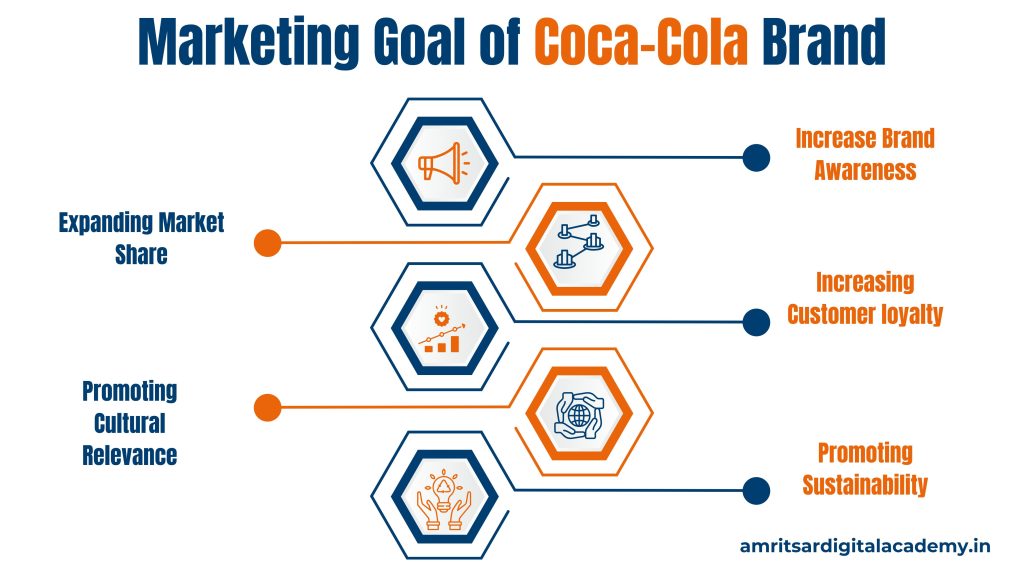
Coca-Cola marketing strategy is designed to increase brand awareness, enhance customer loyalty, and customer sustainability. Coca-Cola sets clear goals to boost its brand, build stronger connections with customers, and stay ahead in the beverage market.
Increase Brand Awareness
With strong marketing strategies Coca-Cola stabilize its position in competitive beverage market. One of the key growth strategies to enhance brand awareness is strong advertising by Coca-Cola.
To reach broad audience company starts sponsoring major events like music festivals and cultural events. Coca-Cola strategically uses social media platforms to maintain customer loyalty. Through these interactions company boosts its brand, builds loyal fans, and creates lively community of dedicated customers.
Expanding Market Share
- The company continuously adapts new digital marketing strategies by monitoring market trends and customer preferences.
- To expand market share company focuses on new product innovation and diversification.
- To attract new customers company starts adding new flavors, new packaging, and new product formats.
- Focus on adding new elements to products like healthier beverage options to target new audiences.
- The company plans to enter new markets by partnering with local distributors and retailers. This helps Coca-Cola use its partner’s networks and knowledge to establish itself in new areas.
Increasing Customer loyalty
Coca-Cola builds strong customer relationships and loyalty through exceptional brand experiences and personalized marketing. Coca-Cola uses customer data to target specific groups and create personalized marketing messages by aiming to build stronger connections with its customers.
Promoting Cultural Reference
Coca-Cola creates marketing campaigns that celebrate diversity and inclusivity, aiming to reflect the different cultures and communities it serves. This helps the brand connect deeply with consumers and stay culturally relevant.
Promoting Sustainability
The company has set big sustainability goals and includes them in its marketing to show its commitment to social and environmental issues. By sharing these sustainability initiatives with consumers, Coca-Cola aims to position itself as responsible and environmentally conscious brand.
What are the Secrets Behind Coca-Cola Marketing Strategy?
Coca-Cola marketing strategy is blend of traditional and innovative approaches that have helped it maintain its position as global leader in the beverage industry. Let’s get into the successful Coca-Cola marketing strategies:
Who is Coca-Cola Target Audience?
The major reason behind the success of Coca-Cola is targeting perfect segmentation of the target audience. Coca-Cola has covered consumer’s hearts over the century. Let’s check how the company targets perfect segmentation:
Demography
The main target audience of this company is young adults, ages between 14 to 30. This age group is big part of their customers because they have money to spend, want to connect socially, and like drinking soft drinks. This company targets families with children because they influence brand choices. The brand appeals to various ethnic groups, genders, and income levels, making it accessible to many people.
Geography
Coca-Cola brand is famous all over the world which proves its geographical presence is not bound. Coca-Cola customizes its messages, packaging, and products to fit each market’s preferences, helping the brand stay relevant and appealing worldwide.
Psychography
Coca-Cola targets the audience through their psychological behavior. The company connects to the target audience who value happiness, social connections, and fun. This brand increases the movements of happiness and celebration.
Behavior
Coca-Cola knows its customers want refreshment, convenience, and a sense of belonging. To meet these needs Coca-Cola makes its products easily accessible through vending machines, convenience stores, and online platforms.
What Makes Coca-Cola’s Marketing Mix So Effective?
Marketing mix is the fundamental concept of marketing, the combination of the four Ps of marketing: product, price, promotion, and place. Each concept plays an important role in brand marketing strategy.
Product
A clear product mix strategy is crucial for market success. Coca-Cola maintains its command of the beverage industry with its comprehensive product mix strategy. Coca-Cola targets diverse segments by launching diverse portfolio of beverages like soft drinks, fruit juice, energy drinks, and sports drinks. This diversified brand portfolio of beverages has led to the success of Coca-Cola in the global world.
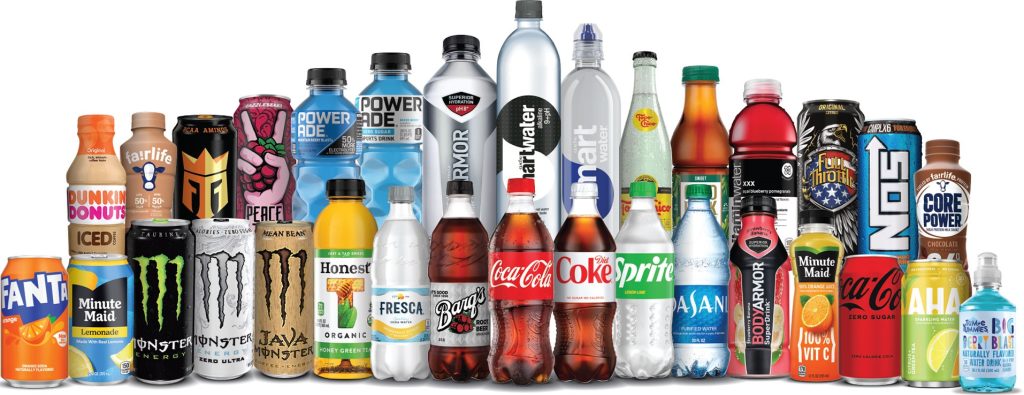
Innovation plays very important role in making success of the brand. Coca-Cola follows this innovative product mix strategy by launching new products and flavors. Coca-Cola also focuses on innovative packaging of the product. This soft drink brand gives superior product quality to their consumers so they can build trust in customers.
Another aspect of product mix strategy is branding and logo of the the product. Coca-Cola creates brand image all over the world by connecting emotionally with the target audience. The notable Coca-Cola logo with red and white color scheme are instantly recognizable by consumers which creates strong brand visibility globally.
Price
Coca-Cola mainly focuses on two important aspects of pricing strategy i.e. profitability and market share. With the effective implementation of its pricing strategy Coca-Cola secures its position in the competitive beverage industry. Coca-Cola follows value based pricing approach in their pricing strategy.
This method focuses on what customers think they are getting when they buy product. By looking at the benefits, convenience, and quality that Coca-Cola offers, the company sets prices based on how valuable customers think the products are.
This way Coca-Cola can charge higher prices for its popular brands and keep prices competitive for its cheaper options.
Promotion
Coca-Cola needs to keep its promotional efforts engaging and maintain brand awareness. This requires strong and effective promotional strategy using various channels and methods. The company spends lot on ads to stay top of mind and build strong emotional connections with consumers. Coca-Cola creates innovative and creative ads that evoke positive emotions and show the brand as part of happy moments.
The company places its commercials during popular TV shows, sports events, and big events like the Super Bowl. This helps Coca-Cola reach wide audience and strengthen its brand image. Coca-Cola needs to keep its promotional efforts engaging and maintain brand awareness. This requires strong and effective promotional strategy using various channels and methods. The company spends lot on ads to stay top of mind and build strong emotional connections with consumers. Coca-Cola creates innovative and creative ads that evoke positive emotions and show the brand as part of happy moments.
The company places its commercials during popular TV shows, sports events, and big events like the Super Bowl. This helps Coca-Cola reach wide audience and strengthen its brand image.
Coca-Cola also uses digital platforms for its promotions. The company has strong presence on social media platforms like Facebook, Twitter, and Instagram.
Another tactic Coca-Cola uses is partnerships and collaborations. The company often works with popular personalities, organizations, social media influencers, and brands to expand its reach and create innovative marketing campaigns.
Place
Coca-Cola’s success comes from its smart approach to where it sells its products. Coca-Cola has huge distribution network that makes sure its products are available everywhere. They sell directly and work with bottlers, wholesalers, and retailers. This system helps Coca-Cola reach people in both cities and rural areas making their products easy to find.
They have developed online distribution channels and partnered with popular e-commerce platforms and retailers with an online presence. This makes their products more accessible and convenient for consumers.
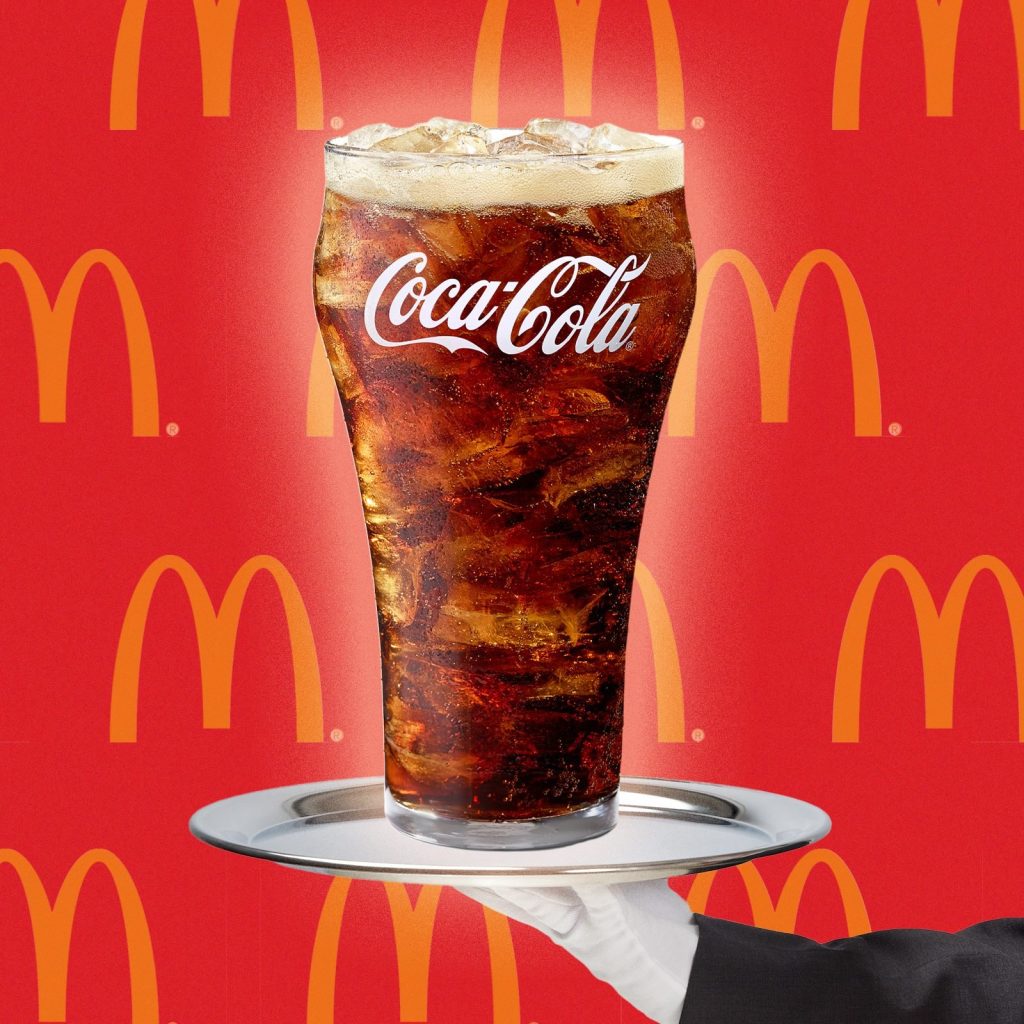
One example of Coca-Cola’s smart placement strategy is partnering with fast food giants like McDonald’s and Burger King. These partnerships increase the availability of Coca-Cola products and create strong brand associations.
How Does Coca-Cola Adapt Its Marketing Strategy Globally?
Coca-Cola covers 360° aspects of marketing by implementing strong marketing strategies. Here are Coca-Cola’s marketing strategies which effectively build strong presence of brand globally.
- Branding Strategy
- Emotion Marketing
- Celebrity Endorsements
- Product Diversifications
- Digital Marketing
- Sponsorship Strategy
Branding Strategy
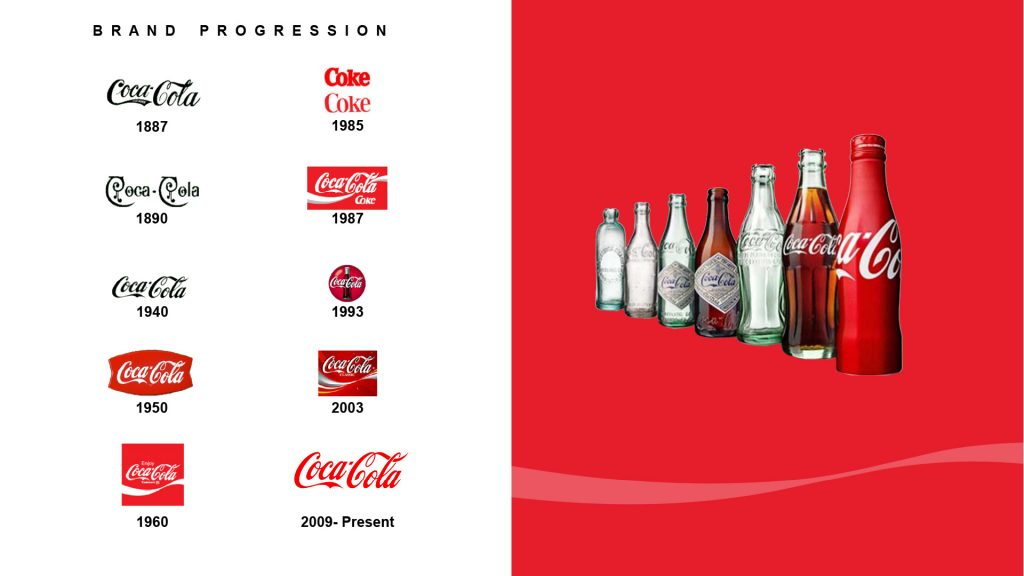
Coca-Cola marketing strategy has played big role in its success with unique branding. By positioning itself as symbol of joy and happiness the company has created positive feelings in consumers and made the brand more appealing.
Their red and white logo and unique bottle design are recognized worldwide. Coca-Cola has used its strong brand image to build trust and reliability among consumers.
Coca-Cola has worked hard to keep its brand consistent. Through ads, packaging, and online presence, they ensure their core message stays the same. By always delivering on its brand promise, Coca-Cola has built strong emotional connection with consumers.
Emotion Marketing
Coca-Cola pinpoints the consumer emotions to build strong connections with their target audience. One of the examples of this approach is the Open Happiness campaign
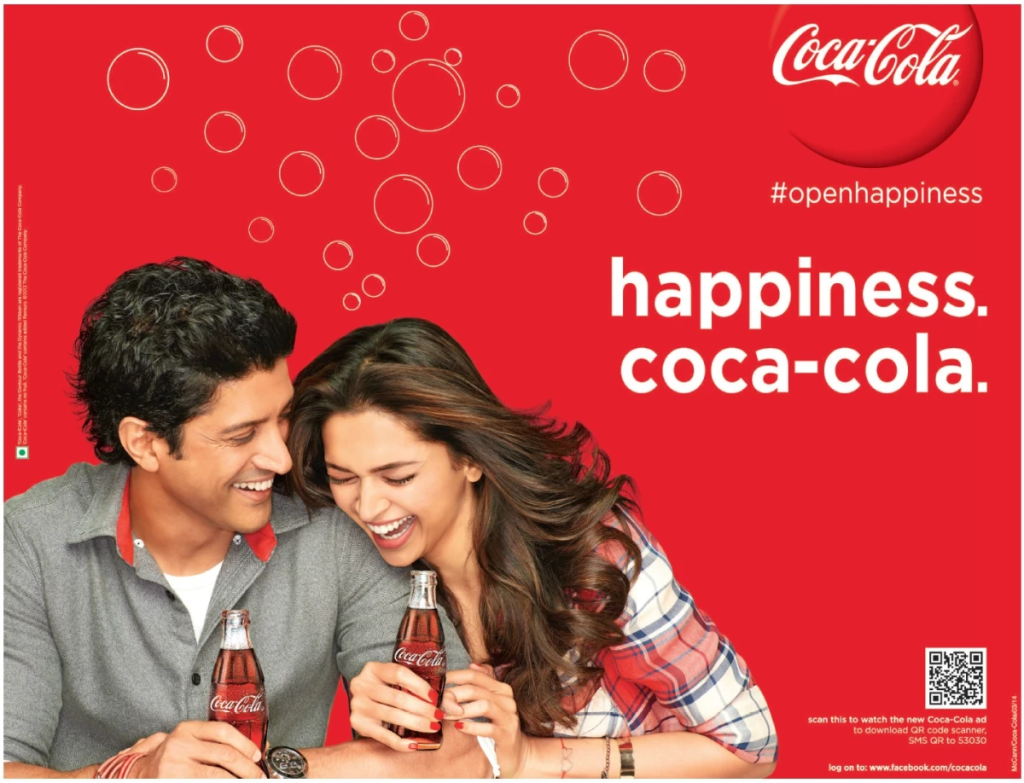
Coca-Cola also uses emotional storytelling to connect with consumers. Their holiday campaigns like the famous “Holidays Are Coming” TV commercial are now linked with the festive season. These ads often show heartwarming scenes and highlight that Coca-Cola is a key part of celebrations and family traditions.
Celebrity Endorsements

Another important part of Coca-Cola’s marketing strategy is using celebrity endorsements. The company partners with famous sports, music, and entertainment figures to leverage their popularity and appeal to their fans.
What makes Coca-Cola’s celebrity endorsements special is their focus on authenticity. They carefully choose endorsers who match their brand values and are seen as genuine by their target audience.
Product Diversification

They introduced Diet Coke for health conscious consumers, and Coca-Cola Zero for those wanting sugar free options. By expanding its product line Coca-Cola stays relevant and captures larger market share.
Digital Marketing
- Coca-Cola uses influencer marketing by working with popular social media personalities to expand its reach and connect with younger audiences.
- The company has spent lot on digital marketing platforms like social media, online ads, and mobile apps to connect with its target audience.
Sponsorship Marketing
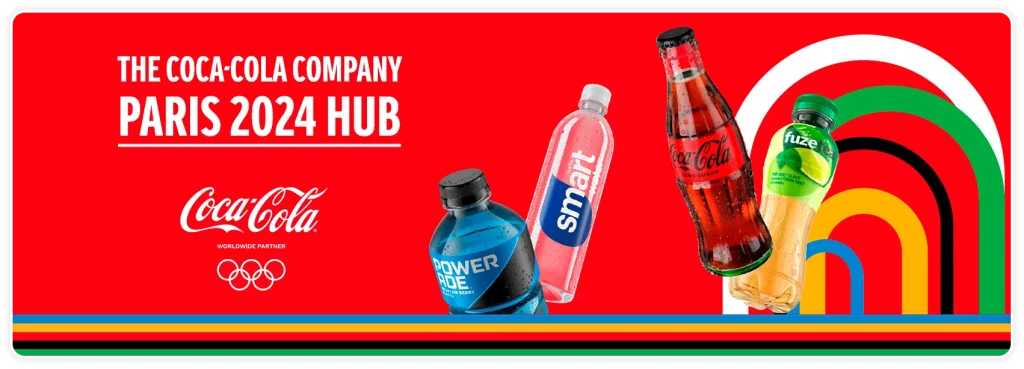
Coca-Cola’s sponsorship strategy includes partnering with sports and cultural events. By sponsoring big events like the FIFA World Cup and the Olympic Games Coca-Cola gains strong presence and reaches large global audience.
SWOT Analysis of Coca-Cola
S= STRENGTHS
W= WEAKNESSES
O= OPPORTUNITY
T= THREATS
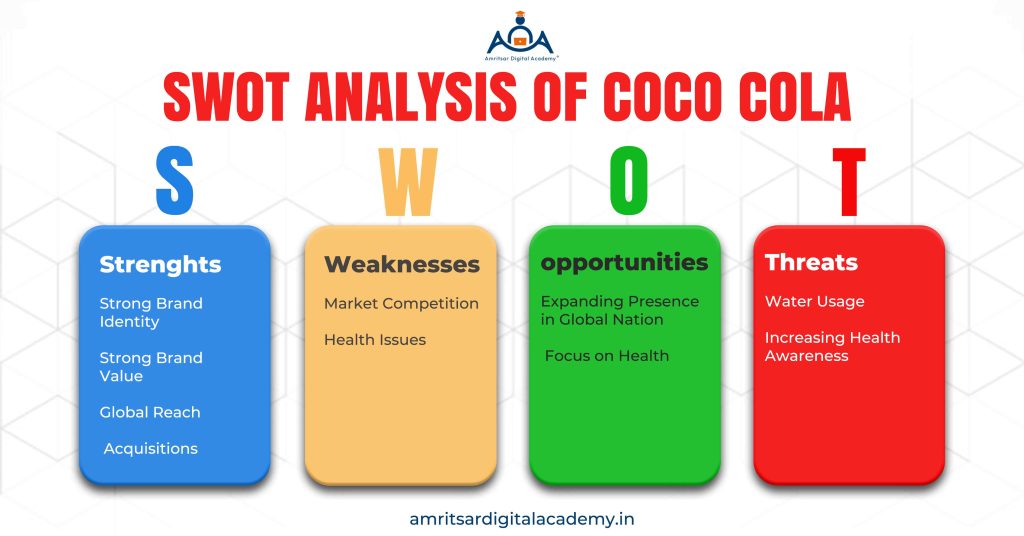
STRENGTHS
- Strong Brand Identity: Coca-Cola established its presence globally. With online marketing campaigns and commercials this company creates brand visibility all over the world.
- Strong Brand Value: Coca-Cola ranked 6th as the best global brand in the beverage industry. With unique Coca-Cola marketing strategies like the festive season designs, customized bottle designs attract consumers.
- Global Reach: Cola-Cola is well known brand in the beverage industry which is available in more than 200 countries. The success of the company relies on meeting consumer beverage needs and providing value to its customers.
- Acquisitions: As we discussed above acquisitions of Coca-Cola prove profitable company acquisitions. With these acquisitions company can build diversified portfolio in the beverage industry.
WEAKNESSES
- Market Competition: In beverage industry the biggest competitor of Coca-Cola brand is Pepsi. Both brands spent lot on marketing and innovation to compete with each other.
- Health Issues: Many health experts suggest avoiding these soft drinks for living healthy life.
OPPORTUNITY
- Expanding Presence in Global Nation: Entering new markets can help the company grow by reaching large number of people who want refreshing soft drinks.
- Focus on Health: This growth strategy shift could raise income and brand image among health-conscious consumers.
THREATS
- Water Usage: Water is essential for our planet and is the main ingredient in Coca-Cola. It takes 3.12 liters of water to make one liter of Coke. Coca-Cola has claimed to support global water equality but this claim is doubtful.
- Increasing Health Awareness: Global health awareness is changing beverage choices. Coca-Cola has introduced “Zero” sugar sodas as sugary soda sales decline. These changes aim to gain customer trust in ingredient safety and come with higher production and marketing costs.
Marketing Channels of Coca-Cola
Retail Stores: You can find Coca-Cola products in supermarkets, convenience stores, and gas stations.
Restaurants and Cafes: Coca-Cola partners with many restaurants and cafes worldwide so you can enjoy their drinks with your meals.
Vending Machines: Coca-Cola’s vending machines are placed in busy areas like malls, schools, and transportation hubs making it easy to grab drinks.
Online Channels: Coca-Cola sells its products on its website and popular e-commerce platforms, directly engaging with customers.
Collaborations: Coca-Cola teams up with other brands and influencers to create special products and marketing campaigns, increasing their visibility.
Mobile Marketing: Coca-Cola marketing strategy uses mobile like SMS campaigns, mobile apps, and location-based ads to reach consumers on their phones.
Final Verdict
Coca-Cola’s journey shows how a brand can grow and change over time while staying true to its core values. Its success comes from mixing tradition with innovation, keeping it relevant to consumers worldwide. By prioritizing sustainability, embracing digital changes, and focusing on consumers, Coca-Cola keeps strengthening its position as a global leader.
Share your thoughts if you find this Coca-Cola’s case study helpful.




